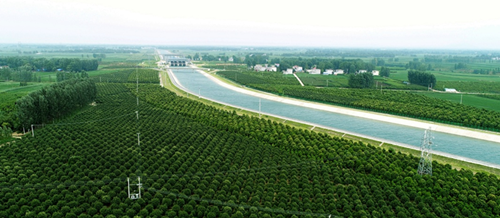Greening projects boost Nanyang

South-to-North Water Diversion Project in Nanyang [Photo/01ny.cn]
Nanyang is a national forest city. The total amount of afforestation has ranked first in the province for many years. Its forested area is 14.68 million mu in size, accounting for nearly a quarter of the province. The planned construction area of the State Reserve Forest Project is 3.9 million mu, which is the largest among the prefecture-level cities in the country.
Relying on mountains, rivers, forests, fields, lakes and grasses, Nanyang has established eight national and provincial nature reserves with an area of 3.73 million mu, and 18 national and provincial forests and wetland parks with an area of 1.03 million mu.
In addition, the city has implemented the “whole-regional Party building + river chief system” model, adheres to the leadership of Party building, gathers all levels to govern the river, and stimulates the vitality of water governance in the whole region.
From the head of the canal to the main canal, a group of volunteers participate in water quality protection. The city's water quality operation "five members" inspected 8,286 people. Nanyang was the first in the province to introduce the "pond chief system", with 16,000 pond chiefs and pond managers. The comprehensive treatment of "thousands of villages and tens of thousands of ponds" has become one of the highlights of the province's four-water management work, and has been selected for 29 cases of grassroots water management experience across the country.
As the source of water intake for the South-to-North Water Diversion Project, Nanyang has sent 37.6 billion cubic meters of water to cities along the Beijing-Tianjin line in the South-to-North Water Diversion Project, directly benefiting more than 100 million people.
Since the middle route of the South-to-North Water Diversion Project was opened, there has been 3.61 million mu of afforestation in the city, 1.32 million mu in the catchment area and52,000 mu in the Danjiangkou reservoir area, a forest coverage rate of more than 55 percent in the catchment area, and 14.68 million mu in the city’s forest area.
The city has a total of 204 certified organic products, 142 green foods, and a production base of green organic agricultural products reaching 1.41 million mu.
The installed capacity of new energy was 2.93 million kilowatts, of which 583,000 kilowatts stemmed from the photovoltaic poverty alleviation project that benefited 84,000 households.
